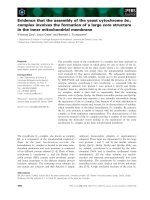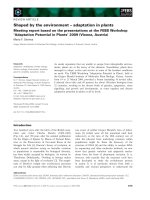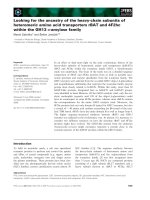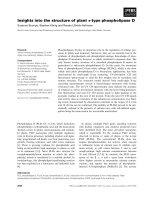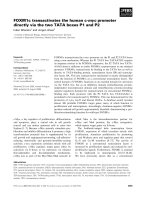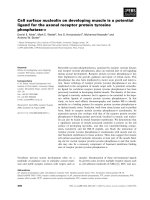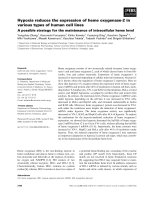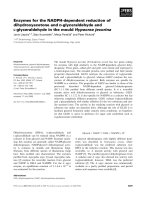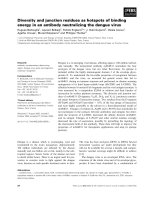Báo cáo khoa học: Exosites mediate the anti-inflammatory effects of a multifunctional serpin from the saliva of the tick Ixodes ricinus potx
Bạn đang xem bản rút gọn của tài liệu. Xem và tải ngay bản đầy đủ của tài liệu tại đây (510.34 KB, 12 trang )
Exosites mediate the anti-inflammatory effects of a
multifunctional serpin from the saliva of the tick
Ixodes ricinus
Pierre-Paul Prevot
1
, Alain Beschin
2,3
, Laurence Lins
4
,Je
´
ro
ˆ
me Beaufays
1
, Ame
´
lie Grosjean
5,6
,
Le
´
a Bruys
2,3
, Benoı
ˆ
t Adam
4
, Michel Brossard
5,6
, Robert Brasseur
4
, Karim Zouaoui Boudjeltia
5,6
,
Luc Vanhamme
1,7,
* and Edmond Godfroid
1,
*
1 Laboratoire de Biologie Mole
´
culaire des Ectoparasites, Universite
´
Libre de Bruxelles, Gosselies, Belgium
2 Department of Molecular and Cellular Interactions, VIB, Brussels, Belgium
3 Laboratory of Cellular and Molecular Immunology, Vrije Universiteit Brussel, Belgium
4 Centre de Biophysique Mole
´
culaire et Nume
´
rique, Faculte
´
Universitaire des Sciences Agronomiques de Gembloux, Belgium
5 Laboratoire de Me
´
decine Expe
´
rimentale, Universite
´
Libre de Bruxelles, Montigny-le-Tilleul, Belgium
6 Institut de Zoologie, Universite
´
de Neucha
ˆ
tel, Switzerland
7 Parasitologie Mole
´
culaire, Institut de Biologie et de Me
´
decine Mole
´
culaires (IBMM), Universite
´
Libre de Bruxelles, Gosselies, Belgium
Ticks are hematophagous arachnid ectoparasites, sec-
ond only to mosquitoes as pathogen vectors worldwide
[1]. Ixodes ricinus is widely found in Europe and is
able to take its blood meal from a variety of verte-
brates, ranging from amphibians to mammals, and
including domestic animals and humans [2]. It is the
one of the vectors of Borrelia burgdorferi, the agent of
Lyme disease. I. ricinus is characterized by a long-last-
ing blood meal, leaving time for its host to activate
defensive reactions such as pain (stimulating scratch-
ing) and hemostasis (repairing the wound and involv-
ing coagulation), as well as innate, adaptive immune
Keywords
inflammatory; receptor binding domain;
sepsis; serpin; tick
Correspondence
E. Godfroid, Laboratoire de Biologie
Mole
´
culaire des Ectoparasites, Institut de
Biologie et de Me
´
decine Mole
´
culaires
(IBMM), Universite
´
Libre de Bruxelles, rue
des professeurs Jeener et Brachet 12,
B-6041 Gosselies, Belgium
Fax: +32 2 650 9900
Tel: +32 2 650 9934
E-mail:
*These authors contributed equally to this
work
(Received 4 February 2009, revised 2 April
2009, accepted 3 April 2009)
doi:10.1111/j.1742-4658.2009.07038.x
Serine protease inhibitors (serpins) are a structurally related but function-
ally diverse family of ubiquitous proteins. We previously described
Ixodes ricinus immunosuppressor (Iris) as a serpin from the saliva of the
tick I. ricinus displaying high affinity for human leukocyte elastase. Iris also
displays pleotropic effects because it interferes with both the immune
response and hemostasis of the host. It thus inhibits lymphocyte prolifera-
tion and the secretion of interferon-c or tumor necrosis factor-a by periph-
eral blood mononuclear cells, and also platelet adhesion, coagulation and
fibrinolysis. Its ability to interfere with coagulation and fibrinolysis, but
not platelet adhesion, depends on the integrity of its antiproteolytic reactive
center loop domain. Here, we dissect the mechanisms underlying the inter-
action of recombinant Iris with peripheral blood mononuclear cells. We
show that Iris binds to monocytes ⁄ macrophages and inhibits their ability
to secrete tumor necrosis factor-a. Recombinant Iris also has a protective
role in endotoxemic shock. The anti-inflammatory ability of Iris does not
depend on its antiprotease activity. Moreover, we pinpoint the exosites
involved in this activity.
Abbreviations
CHO, Chinese hamster ovary; FITC, fluorescein isothiocyanate; IL, interleukin; Iris, Ixodes ricinus immunosuppressor; LPS,
lipopolysaccharide; MCP-1, monocyte chemoattractant protein-1; PBMC, peripheral blood mononuclear cell; PDB, Protein Data Bank; RBD,
receptor binding domain; RCL, reactive center loop; rIris, recombinant Iris; serpins, serine protease inhibitor; TNF-, tumor necrosis factor.
FEBS Journal 276 (2009) 3235–3246 ª 2009 The Authors Journal compilation ª 2009 FEBS 3235
reactions. In response, ticks have evolved a battery of
countermeasures [3–7], mainly involving salivary pro-
teins, several of which are induced during the feeding
process and injected at the site of the wound. Some of
these proteins have been identified in several tick spe-
cies [8–17]. They comprise a variety of enzymes inter-
fering with different physiological processes. We have
previously reported the construction and analysis of a
cDNA subtractive library which led to the identifica-
tion of I. ricinus immunosuppressor (Iris), a protein
expressed in the salivary glands and secreted in the
saliva during the blood meal [18–20]. Structural analy-
sis and site-directed mutagenesis confirmed that Iris is
a member of the serine protease inhibitor (serpin)
family. The protein structure of serpins is characterized
by three b sheets (A, B and C) and eight or nine
a helices [21]. A typical feature of serpins is the reac-
tive center loop (RCL), a protein motif of 20 amino
acids, located near the C-terminus of the protein. This
motif contains a scissile bond between the so-called
residues P1 and P1¢, which is cleaved by the target pro-
tease. This cleavage triggers structural rearrangement
of both the protease and the inhibitor in a suicide
mechanism that irreversibly complexes and inactivates
both interacting partners. All these features have been
uncovered in Iris [21]. However, because serpins are
involved in a wide variety of physiological processes,
prediction of the function of Iris in tick saliva based
solely on its belonging to this family was precluded.
We previously expressed Iris as a recombinant pro-
tein and showed that it inhibits serine proteases such
as human leukocyte elastase, tissue plasminogen acti-
vator, thrombin and factor Xa. Affinity rate constants
and inhibition values indicated that Iris preferentially
targets the human leukocyte elastase. [21] In addition,
in agreement with its enzymatic activity, Iris was
shown to interfere with coagulation and fibrinolysis
[21]. These effects were dependent on the protease
inhibitory function of the RCL domain of Iris, because
the Leu339Ala (P2) mutant devoid of antiprotease
activity did not influence coagulation or fibrinolysis.
However, Iris also increases the platelet adhesion time
[21]; an activity not affected by the mutation. This sug-
gests that domains other than the RCL are involved in
this distinct protein activity. To add to the multifunc-
tionality of this protein, Iris has also been found to
modulate cytokine production by human peripheral
blood mononuclear cells (PBMC) [18]. Leboulle et al.
demonstrated that soluble protein extracts of Chinese
hamster ovary (CHO)-KI cells expressing recombinant
Iris (rIris) inhibited the production of tumor necrosis
factor (TNF-)a, interleukin (IL)-6, IL-8 and inter-
feron-c triggered by lipopolysaccharide (LPS).
Here, we further address the multifunctional charac-
ter of Iris. More precisely, we dissect its anti-inflamma-
tory activity. The results indicate that Iris inhibits
TNF-a production by direct interaction with the
monocyte ⁄ macrophage populations of PBMC. More-
over, its ability to interfere with TNF-a production is
independent of its antiprotease activity. Finally, we
also provide evidence that Iris, as an inhibitor of
TNF-a production, may be used as a therapeutic tool
against endotoxemic shock.
Results
Iris inhibits TNF-a production by PBMC
We have previously reported that the tick salivary ser-
pin Iris could interfere with the immune response.
Indeed, total soluble protein extracts from CHO-KI
cells expressing rIris–6His inhibited the production of
TNF-a by PBMC which had been activated by the
Toll-like receptor (TLR)-4 trigger, LPS [18]. In order
to dissect the mode of action of Iris, we purified large
amounts of the protein expressed in a baculovirus sys-
tem. We first investigated the ability of Iris to suppress
production of TNF-a by PBMC stimulated with LPS.
Because levels of TNF-a production by PBMC vary
between healthy donors, prior experiments on multiple
donors were performed to determine the appropriate
rIris concentration range for these studies. This range
was found to be 10–400 nm (results not shown). In all
experiments, dexamethasone was used as a control to
inhibit LPS-induced TNF-a production [22]. The
results shown in Fig. 1 (from three independent
***
***
***
***
***
Fig. 1. Effect of rIris on TNF-a production by LPS-stimulated
human PBMC. PBMC were activated by LPS (10 lgÆmL
)1
) for 4 h
in the presence or absence of the indicated rIris concentrations.
TNF-a concentrations were then measured in the harvested super-
natants. DEX, dexamethasone (10 l
M) was used as positive control
for inhibition of TNF-a production; NS, nonstimulated cells; LPS,
LPS-stimulated cells. Values are the mean of three experiments
(± SD). *P < 0.05, **P < 0.01, ***P < 0.001 compared with
controls (one-way ANOVA).
Exosites mediate anti-inflammatory effects of Iris P P. Prevot et al.
3236 FEBS Journal 276 (2009) 3235–3246 ª 2009 The Authors Journal compilation ª 2009 FEBS
experiments performed on one representative in five
donors using the appropriate concentration range)
indicate that the pure recombinant protein inhibited
TNF-a production by PBMC which had been stimu-
lated by LPS. This effect was dose dependent, reaching
a maximum at 200–400 nm Iris. Iris also impaired the
spontaneous release of TNF-a by PBMC (Fig. 1).
Moreover, the ability of Iris to impair TNF-a pro-
duction could be inhibited by polyclonal anti-Iris
serum [20]. Indeed, as shown in Fig. 2, increasing
concentrations of anti-Iris serum progressively restored
TNF-a levels in the PBMC supernatant to the values
induced by LPS stimulation in the absence of Iris. This
effect was presumably related to the specific neutraliza-
tion of Iris because the preimmune serum remained
without effect.
Furthermore, Iris inhibited not only the production
of TNF-a by PBMC activated via the TLR4 ⁄ LPS
pathway, but also, to varying extents, by peptidogly-
can (PGN), poly(I : C) and ODN 2006, which are
recognized by TLR2, TLR3 and TLR9, respectively
(Table 1). Dexamethasone (10 lm) was used as a
positive control and, as expected, inhibited TNF-a
production by 95%.
Together, these data show that Iris inhibited TNF-a
production by PBMC and suggested that this activity
was independent of the TLR stimulus.
Iris binds to monocytes/macrophages
To investigate which PBMC subset population was the
target of rIris, flow cytometry experiments were per-
formed. Fluorescent-labeled Iris did not bind on CD3)
(T lymphocytes), or CD19) (B lymphocytes) positive
cells (results not shown). By contrast, Iris binding was
detected on both the CD11b+ CD14+ CD16+ and
CD11b+ CD14+ CD16) monocyte subsets (Fig. 3).
Moreover, the binding of fluorescent-labeled Iris could
be competed out by co- or preincubation with anti-Iris
serum but not with preimmune sera. Furthermore, bind-
ing of fluorescent-labeled Iris to monocytes could be
abrogated by co- or preincubation with nonlabeled
Iris, but not by co- or preincubation with LPS (not
shown).
Inhibition of LPS-induced TNF-a release is
independent of the antiprotease activity of Iris
We next asked whether the inhibiting effect of Iris on
TNF-a released by LPS-activated PBMC was depen-
dent on its serpin activity. For that purpose, rIris, its
cleaved elastase-complexed form or the mutant L339A
(the latter two lacking antiprotease activity) were
***
***
**
Fig. 2. Polyconal anti-rIris serum neutralize the capacity of Iris to
inhibit the release of TNF-a by LPS-activated PBMC. PBMC were
incubated for 4 h with or without LPS (10 lgÆmL
)1
) in the presence
(+rIris) or absence ()rIris) of 100 n
M rIris that had been preincuba-
ted for 5 min at 37 °C with the indicated dilutions of anti-Iris serum.
TNF-a concentrations were measured in the harvested superna-
tants. ⁄ , no antibody added; PI, preimmune serum. Values are the
mean of three experiments (± SD).
Table 1. Effect of recombinant Ixodes ricinus immunosuppressor (rIris) on production of tumor necrosis factor-alpha (TNF-a) by peripheral
blood mononuclear cells (PBMC) stimulated via distinct Toll-like receptors (TLRs). PBMC (2 · 10
5
cellsÆwell
)1
) were incubated with the
indicated chemicals [lipopolysaccharide (LPS), 10 lgÆmL
)1
; peptidoglycan (PGN), 10 lgÆmL
)1
; poly(I : C) 10 lgÆmL
)1
or ODN 2006, 2 lgÆmL
)1
]
in complete RPMI-1640 medium supplemented or lacking rIris (400 n
M). Cells were left at 37 °C, 5% CO
2
for 4 or 24 h, as indicated.
Culture supernatants were harvested and TNF-a dosed by ELISA. Numbers are the mean of three experiments (± SD) of three individuals
per experiment.
TNF-a production
(pgÆmL
)1
)
PBMC stimulation
LPS (100 ngÆmL
)1
) PGN (2 lgÆmL
)1
) Poly(I : C) (10 lgÆmL
)1
) ODN 2006 (10 lgÆmL
)1
)
After 4 h Iris 295.9 (± 32.4)*** 61.4 (± 2.4)*** 145.9 (± 27.1)* 342.3 (± 43.7)***
Control 1174.1 (± 138.1) 98.6 (± 5.8) 222.7 (± 41.4) 736.4 (± 89.6)
After 24 h Iris 701.4 (± 102.4)** 89.1 (± 9.4)*** 409.1 (± 37.1)*** 240.5 (± 23.2)***
Control 1338.2 (± 124.9) 418.6 (± 42.4) 885.5 (± 49.7) 1226.4 (± 101.8)
*P < 0.05, **P < 0.01, ***P < 0.001 compared with controls (one-way ANOVA).
P P. Prevot et al. Exosites mediate anti-inflammatory effects of Iris
FEBS Journal 276 (2009) 3235–3246 ª 2009 The Authors Journal compilation ª 2009 FEBS 3237
added to LPS-stimulated PBMC before evaluating
TNF-a production.
As illustrated in Fig. 4, all forms of Iris tested,
whether retaining the serpin activity (native rIris) or not
(L339A mutant, cleaved elastase-complexed Iris), had a
similar effect: their addition to LPS-stimulated PBMC
resulted in a progressive (dose-dependent) reduction in
TNF-a release compared with the cells stimulated with
LPS alone. The effect was maximal at 400 nm, reducing
TNF-a release to a level lower than that produced by
PBMC cultured without LPS stimulation (not shown).
These results showed that inhibition of TNF-a release
by Iris does not require its serine protease inhibitor
activity or integrity of the RCL domain.
Exosites mediate the inhibitory effect of Iris on
TNF-a production
The similar effects of wild-type native, cleaved prote-
ase-complexed and RCL mutant forms of Iris on
TNF-a production suggested that Iris activity was
independent of serpin activity ⁄ domain.
Therefore, we sought to predict the domains of Iris
distinct from the RCL domain that may potentially
CD16
10
4
10
5
Comp-PE-A
Comp-FITC-A
10
3
0
CD14
CD14
–
CD14
+
x
80
100
B C
A
60
100
80
60
% of Ma
% of Max
40
20
40
20
Comp-FITC-A
Comp-FITC-A
0
0 10
3
10
4
10
5
0 10
3
10
4
10
5
0 10
3
10
4
10
5
0
Fig. 3. Iris interacts with the mono-
cyte ⁄ macrophage PBMC population. PBMC
were incubated with fluorescent-labeled
rIris, CD14 and CD16 antibodies. (A) Expres-
sion of CD16 and CD14 on PBMC. (B)
CD14) populations gated in (A) were
analyzed for Iris binding (dotted line,
CD14)
)
CD16+
)
cells; tinted line,
CD14) CD16)cells). (C) CD14+ populations
gated in (A) were analyzed for Iris binding
(dotted line, CD14) CD16+
)
cells; bold line,
CD14+ CD16+ cells, tinted line,
CD14+ CD16)
)
cells). FACS profiles are
representative of one of five individuals
tested in two independent experiments.
Numbers in the FACS profiles indicate the
percentage of cells within the indicated
gates.
0
200
400
600
800
1000
400 200 100 50 25 0
Concentration (n
M)
TNF-α
α
concentration (pg·mL
–1
)
Iris
L339A
Iris + Elastase
Elastase
Fig. 4. Dose-dependent effects of wild-type and mutated rIris on
TNF-a release by LPS-stimulated PBMC. PBMC were activated for
4 h by LPS (10 lgÆmL
)1
) in the presence or absence of wild-type
rIris (Iris), mutant rIris (L339A), rIris–elastase complex (Iris + elas-
tase) or elastase alone (elastase) at the indicated concentrations.
TNF-a concentrations were measured in the harvested cell superna-
tants. In order to prepare the Iris–elastase complex, the two pro-
teins were incubated in equimolar quantities for 1 h at 37 °C. Only
samples with a recorded elastase activity < 25% compared with
the control were used. Values are the mean of three experiments
(± SD).
Exosites mediate anti-inflammatory effects of Iris P P. Prevot et al.
3238 FEBS Journal 276 (2009) 3235–3246 ª 2009 The Authors Journal compilation ª 2009 FEBS
interact with other proteins by molecular modeling.
Two different types of sequence-based methods were
used. On the one hand, potential immunogenic
domains were predicted, based on sequence analysis of
Iris, using a combination of DeLisi & Berzofsky’s [23],
Eisenberg et al.’s [24] and HCA [25] methods. This
approach, predicting accessible, charged amphipathic
fragments [26,27], identified seven putative epi-
topes ⁄ immunogenic fragments located between posi-
tions 7–21 (ep1), 66–79 (ep2), 85–98 (ep3), 105–120
(ep4), 127–143 (ep5), 290–306 (ep6) and 312–325 (ep7)
of Iris (Fig. 5). On the other hand, the RDB method
identified eight regions within Iris as putative pro-
tein ⁄ protein interaction sites (Fig. 5) located between
positions 18–27 [receptor binding domain (RBD)1],
61–71 (RBD2), 91–98 (RBD3), 111–116 (RBD4), 125–
133 (RBD5) 139–150 (RBD6) 190–198 (RBD7) and
223–227 (RBD8), respectively. We relied on a 3D
model of Iris that we had established previously [21]
(Fig. 5) to address the location and accessibility of
these antigenic and RBD domains.
Five of the putative interacting domains identified
by either method were overlapping (RBD1–RBD5).
One (RBD3) was not considered able to form a good
interacting domain because of a bad Berzofsky score.
The properties of the four remaining selected peptides
are summarized in Table 2. The analysis indicated
that: (a) domains 62–67 (overlapping antigenic peptide
ep2), 128–131 and 142–147 (both overlapping peptide
ep5) defined particularly good interacting domains;
and (b) antibodies against peptides 2 and 3 should
interfere with a common interaction site (Fig. 5).
The four peptides described in Table 2 (ep1, ep2,
ep4, ep5) were synthesized and used to immunize rab-
bits. The resulting antisera were evaluated for their
neutralizing effect on the ability of Iris to block LPS-
induced TNF-a production in PBMC. The antibody
titers of the different sera were similar (not shown).
Table 3 shows that antibodies targeting peptides ep2
and ep4 reduced the inhibition of TNF-a production
in a dose-dependent manner, the anti-ep4 serum being
more potent than the anti-ep2 serum. Conversely, anti-
ep1 serum had no effect on the inhibitory action of
Iris. Finally, the action of anti-ep5 serum could not be
analyzed because it inhibited the production of TNF-a
by itself, i.e. in the absence of Iris (data not shown).
From these results, we conclude that the interaction
site responsible for the anti-inflammatory effects of Iris
is a conformational region covering domains RBD2
and RBD4, notably composed of helices D (67–79)
Fig. 5. Potential antigenic epitopes and RBD prediction in Iris. The
3D structure of Iris is represented as a blue ribbon and the P1 resi-
due important for the antiprotease activity is represented in orange
(true volume). The axis of helices D and E and sheet1A is high-
lighted by a green, red or pink arrow, respectively. (A) The
predicted epitopes are represented in yellow and numbered as fol-
lows: (1) 7–21, (2) 66–79, (3) 85–98, (4) 105–120, (5) 127–143, (6)
290–306, (7) 312–325. (B) The predicted RBD are represented in
yellow and numbered as follows: (1) 21–25, (2) 62–67, (3) 92–99,
(4) 111–115, (5) 128–131, (6) 142–147, (7) 192–196, (8) 223–228.
Table 2. Potential amphipathic domains within Ixodes ricinus immunosuppressor (Iris) predicted both as immunogenic epitopes and recep-
tor-binding domain. The first column indicates the amino acid positions in the protein sequence. Angle, the calculated angle between the
helix axis and the plane of a model membrane. ASA, accessible surface area. +, the peptide has an adequate mean surface accessibility
‡ 30%.
Peptide Sequence Total number aa Number positive charge Number negative charge Number polar aa Angle (°) ASA
7–21 NHILNFSVDLYKRLK 15 3 1 4 20 +
66–79 DKIHDHFSSFLCKL 14 2 2 4 0 +
105–120 EYTTLLQKSYDSTIKA 16 2 2 4 0 +
127–143 ADRVRLEVNAWVEEVTR 17 3 4 2 0 +
P P. Prevot et al. Exosites mediate anti-inflammatory effects of Iris
FEBS Journal 276 (2009) 3235–3246 ª 2009 The Authors Journal compilation ª 2009 FEBS 3239
and E (104–114) and sheet 1A (117–121) (Fig. 5).
These domains are distinct from the RCL (amino acids
324–340) involved in the antihemostatic action of Iris
[21] and are not affected by the structural rearrange-
ment during protease inhibition.
Iris delivery inhibits LPS-induced septic shock
Because of its ability to interfere with TNF-a release,
Iris seemed a good candidate to counteract endo-
toxemia. The in vivo half-life of Iris was determined to
verify whether it was appropriate for use in an animal
model of endotoxemia. Figure 6 shows that the
125
I-
labeled Iris concentration in plasma remained stayed
similar for at least 20 h after i.p. injection, decreasing
to 20% of the maximum observed value 44 h after
administration. In order to address the ability of Iris
to counteract endotoxemia, we used a model of murine
sepsis following LPS injection. Mice were separated
into two groups and treated with Iris (30 mgÆkg
)1
, i.p.)
or NaCl ⁄ P
i
respectively. Two hours later, endotoxemia
was induced by LPS injection (40 mgÆkg
)1
, i.p.). As
shown in Fig. 7, the mortality rate in the Iris-treated
group ( 50%) was significantly lower than in the
NaCl ⁄ P
i
-treated group ( 80%) (P < 0.001). Further-
more, mean survival time in the Iris-treated group was
48 h, compared with 24 h in the control group, indi-
cating that Iris increased both survival rate and sur-
vival time. In order to discount the possibility of a
BSA-like effect for rIris, we injected mice with the
same amount of ovalbumin, another serpin. As
expected, there was a significant difference in mortality
rate between rIris- and ovalbumin-treated groups
(P = 0.0019), whereas no difference was found
between the NaCl ⁄ P
i
- and ovalbumin-treated groups.
However, when administrated after the induction of
endotoxemia, Iris remained without effect (results not
shown). In addition, Iris had no beneficial effect on
caecum ligature puncture-induced sepsis (results not
shown). Because Iris was able to reduce TNF-a release
in a LPS-activated PBMC culture, we asked whether
the protective effect of Iris was related to interference
with the cytokine storm usually associated with septic
death. Figure 8 shows that the administration of Iris
significantly inhibited TNF-a release (P < 0.001), and
to a lesser extent the release of monocyte chemo-
attractant protein-1 (MCP-1) (P < 0.01) and IL-6
(P < 0.05) in the blood following LPS injection.
Table 3. Effect of neutralization of Ixodes ricinus immunosuppres-
sor (Iris) activity on tumor necrosis factor-alpha (TNF-a) production
induced by lipopolysaccharide (LPS) in peripheral blood mononu-
clear cells by polyclonal anti-rIris serum. Results are expressed as
percentage of cytokine concentration recorded in the presence of
LPS and absence of rIris (+LPS; )rIris). ⁄ , no antibody added;
)LPS, no LPS added. TNF-a expression values are expressed in
percentage relative to control ()rIris; +LPS)
Antibodies
dilution
TNF-a production
+rIris )rIris
+LPS +LPS
10 20 40 80 ⁄⁄ 10
Anti-ep1 28 24 24 23 25 100 2
Anti-ep2 56 43 32 27 25 100 3
Anti-ep4 80 45 44 31 25 100 6
Fig. 6. Half-life of
125
I-labled Iris in the blood.
125
I-labled Iris (10 lg;
10
7
c.p.m.) was administrated i.p. Blood samples were collected at
the indicated times by cardiac puncture, and platelet-poor plasma
was prepared by centrifugation. Aliquots were counted in a gamma
counter. Counts per minute per 500-lL aliquots are plotted against
time. Values are the mean of three experiments (± SD).
0 20 40 60 80 100
0
20
40
60
80
100
Iris
PBS
Ovalbumin
(h)
Survival (%)
Fig. 7. Iris treatment protects against LPS-induced toxic shock.
Mice were injected i.p. with rIris (30 mgÆkg
)1
) or NaCl ⁄ P
i
. Two
hours later, septic shock was induced by i.p. administration of
E. coli serotype O111:B4 LPS (40 mgÆkg
)1
). Survival was recorded
and plotted against time as percentage of injected animals surviving
(n = 40).
Exosites mediate anti-inflammatory effects of Iris P P. Prevot et al.
3240 FEBS Journal 276 (2009) 3235–3246 ª 2009 The Authors Journal compilation ª 2009 FEBS
IL-10 production was not affected. This is in
agreement with our previous observation that in vitro
Iris inhibits the LPS-induced increase in TNF-a, inter-
feron-c, IL-6 and IL-8, although IL-10 levels are not
affected [18]. The IL-1b concentration remained too
low to detect any statistically significant difference and
was apparently unaffected during the time course of
the experiment (data not shown). Again, this con-
firmed our previous in vitro measurements [18]. In
summary, Iris is able to increase ⁄ prolong both survival
rate and survival time in mice undergoing LPS-induced
endotoxemic shock. This correlated with a reduction
of endotoxemic cytokine production.
Discussion
Iris as a multifunctional tick saliva protein
The currently documented functions of serpins and
tick saliva suggest a role for tick serpin(s) in the modu-
lation of immune response, coagulation, fibrinolysis,
complement regulation and inflammation or angiogen-
esis [28,29]. In particular, the I. ricinus immunosup-
pressor protein Iris, which is induced in tick saliva
during the blood meal [18–20], was suggested to dis-
turb the TH1 ⁄ TH2 balance by inhibiting interferon-c
production. It was also shown to preferentially target
the human leukocyte elastase or pork pancreatic elas-
tase [21] and, to a lesser extent, tissue plasminogen
activator, coagulation factor X and thrombin. As such,
Iris may act in physiological processes relevant for the
tick blood meal, disturbing its serpin activity hemosta-
sis through interference with fibrinolysis, contact
phase-activated pathway of coagulation and, to a
lesser extent, platelet aggregation. Iris may also exert
anti-inflammatory activity because soluble protein
extracts of CHO-KI cells expressing rIRIS inhibited
production of inflammatory cytokines like TNF-a trig-
gered by LPS [18].
In this study, we documented that affinity-purified
rIris was able to block TNF-a produced by PBMC
activated by various TLR agonists, namely LPS
(TLR4), poly(I : C) (TLR3), ODN 2006 (TLR9) and
PGN (TLR2). Moreover, we indicated how Iris may
exert its blocking effect: Iris was found to interact
physically with the two major monocyte fractions
of PBMC, namely CD11b+ CD14+ CD16) and
CD11b+ CD14+ CD16+ cells [30]. Appropriate con-
trols discarded the possibility of an action mediated by
interference with LPS, reagents used in the dosage,
TNF-a itself or TNF-a half-life (results not shown).
Finally, we also showed that delivery of Iris in vivo
significantly lowered the mortality rate and increased
the survival time of mice undergoing LPS-induced sep-
tic shock. This effect was not observed upon injection
of the same amounts of ovalbumin, another serpin,
used as a control, arguing against a BSA-like effect
(Fig. 7). The observed protective effect of Iris was
correlated with the inhibition of TNF-a, MCP-1 and
IL-6 production, all of which participate in the cyto-
kine storm associated with LPS endotoxinemia [31,32].
Of note, Iris had no activity in caecum ligature punc-
ture-induced sepsis (not shown). This is reminiscent of
the lack of action of specific anti-TNF-a IgG in the
latter pathology and in agreement with the lack of
involvement of TNF-a in this model [33]. However,
Iris had a significant beneficial effect only when admin-
istrated before LPS-induced endotoxemic shock (not
Fig. 8. Effect of rIris on LPS-induced cyto-
kine release in vivo. Mice were injected
i.p. with rIris (30 mgÆkg
)1
) or NaCl ⁄ P
i
. Two
hours later, septic shock was induced by
i.p. administration of E. coli serotype
O111:B4 LPS (40 mgÆkg
)1
). TNF-a, IL-6,
MCP-1 and IL-10 levels were measured in
the platelet-poor plasma collected by cardiac
puncture at the indicated times post injec-
tion of LPS. Results are expressed as
means ± SEM of six mice per group for
each time point. *P < 0.05, **P < 0.01,
***P < 0.001 compared with controls
(one-way ANOVA).
P P. Prevot et al. Exosites mediate anti-inflammatory effects of Iris
FEBS Journal 276 (2009) 3235–3246 ª 2009 The Authors Journal compilation ª 2009 FEBS 3241
shown). This may be expected, because maximal TNF-
a levels are recorded very shortly (90 min) after LPS-
induced endotoxemic shock, suggesting the need for
immediate action in order to interfere.
Exosites mediate the anti-inflammatory
action of Iris
There are straightforward connections between the
enzymatic function of Iris – a specific inhibitor of leu-
kocyte elastase – and some of its putative physiological
activities. In this regard, the proinflammatory effects
of fragments generated from extracellular matrix deg-
radation by elastase are well documented. For exam-
ple, degradation products of elastin or heparan sulfate
proteoglycan can act as chemoattractants towards
inflammatory cells or activate TLR4, respectively
[34,35]. TLR4 activation by LPS, responsible for fever,
shock and death in sepsis, is thought to be prevented
in vivo by the extracellular matrix. By cleaving matrix
proteins, elastase liberates TLR4 from this extracellu-
lar matrix constraint, favoring its interaction with
potential ligands and activation of the inflammatory
immune reaction [36]. Leukocyte elastase has also been
found to modulate chemokine and cytokine activity,
activate cell-surface receptors and cleave the antiadhe-
sive coat of neutrophils [34,37]. Therefore, by inhibi-
ting leukocyte elastase, Iris could clearly interfere with
the inflammatory response. Through its inhibition of
tissue plasminogen activator, factor X and thrombin,
Iris may also interfere directly with coagulation.
The reported data nevertheless suggested that some
functions of Iris were independent of its enzymatic
inhibitory activity. Indeed, both wild-type Iris and the
mutant devoid of serpin activity (L339A; P2) were
found to similarly increase platelet adhesion time [21].
This was reminiscent of the biological activity of native
alpha-1-antitrypsin, which was shown to be indepen-
dent of its inhibitory activity on serine proteases [38].
Moraga et al. [39] demonstrated that cleaved (devoid
of activity) alpha-1-antitrypsin still has an effect on
IL-6 and TNF-a production by monocytes ⁄ macro-
phages. This action was inferred to the presence of
exosites within alpha-1-antitrypsin. Similar assump-
tions could be made regarding Iris.
To test this hypothesis, we first evaluated whether
the ability of Iris to inhibit TNF-a released by PBMC
activated by LPS was dependent on the activity ⁄ integ-
rity of the RCL (anti-proteasic domain). Wild-type Iris
and its inactive mutant L339A inhibited release of the
inflammatory cytokine to the same extent. This is in
sharp contrast to the effect of rIris on fibrinolysis, an
activity lost in the RCL mutant [21]. This indepen-
dence of the protease inhibitory activity of the
anti-inflammatory activity of Iris was further sup-
ported using the cleaved ⁄ inactivated Iris protein
obtained by incubation with its target serine protease.
We observed that an elastase ⁄ Iris complex retains its
inhibitory activity on the production of TNF-a. This
further confirms that Iris devoid of its inhibitory activ-
ity still inhibits TNF-a production. It further indicates
that Iris preserves its anti-inflammatory activity even
after a conformation change.
Because an intact RCL domain seems dispensable
for the inhibitory action of Iris on TNF-a production,
the contribution of exosites was evaluated. These can
be predicted using either the RBD method [26] or by
epitope predicting (according to the Berzofsky, Eisen-
berg and HCA methods). According to the most strin-
gent criteria of the two methods, four antigenic
peptides were selected within Iris and synthesized to
generate specific antibodies. Antibodies targeting two
of these peptides were shown to impair the ability of
Iris to inhibit TNF-a by LPS-activated PBMC. Anti-
ep2 serum had an activity twice as low as that of
anti-ep4 serum. Because the different sera had the
same antibody titer and were used at the same dilu-
tion, this might translate into a real biological differ-
ence and be related to the 3D location of these
epitopes. The antigenic fragments are close in the 3D
structure and correspond to helices D and E-s1A (posi-
tions 2, helix D, and 4, helix E-s1A, in Fig. 5A).
Therefore, an interacting site, involved in the anti-
inflammatory function of Iris, corresponds to a region
involving helices hD and hE. However, it cannot be
ruled out that only the helix E-s1A region is implicated
in inhibition of TNF-a release, because antibodies tar-
geting helix E seem more potent inhibitors (although
displaying the same affinity); the effects observed with
antibodies targeting helix D may be related to an arti-
fact caused by steric hindrance, antibodies masking
helix E when binding to helix D (Fig. 8). Further
mutational studies could be performed to verify
whether the helix D region is truly implicated in the
immunomodulatory function of Iris. However, these
different mutations (with one or more mutations on a
large peptide of 16 amino acids) might weaken the
protein structure and distort the functional analysis.
To summarize, we showed that Iris exerts an anti-
inflammatory action, blocking the release of TNF-a by
various TLR agonist-activated monocytes, independent
of the RCL and antiprotease activity. This action is
mediated by (an) exosite(s) (RBD2 and RBD4), nota-
bly composed of helices D (67–79) and E (104–114)
and sheet 1A (117–121), likely to mediate direct inter-
action with monocytes. Thus, Iris might be beneficial
Exosites mediate anti-inflammatory effects of Iris P P. Prevot et al.
3242 FEBS Journal 276 (2009) 3235–3246 ª 2009 The Authors Journal compilation ª 2009 FEBS
for the parasite, by interfering with hemostasis [21],
and for the host by blocking excessive serine protease
activity during acute inflammation and regulating the
expression of pro- and anti-inflammatory mediators.
This may prove particularly useful when removed from
the parasite–host interaction context because it may
form the basis of a drug acting in pathological situa-
tions involving the overexpression of TNF-a.
Materials and methods
Preparation of rIris, mutant L339A and the
cleaved forms of rIris
Purified recombinant wild-type Iris (rIris) (Fig. S1) and
mutant L339A were produced in a baculovirus expression
system, according to Prevot et al. [21]. The cleaved form of
rIris was obtained by incubation for 1 h at 37 °Cinthe
presence of equimolar amounts of pancreatic elastase. Puri-
fication buffers were prepared with Limulus amoebocyte
lysate reagent water (Lonza, Valais, Switzerland). Purified
proteins were diluted in NaCl ⁄ P
i
(pH 7.4) and tested for
endotoxin contamination using the QCL-1000 kit (Lonza).
Endotoxin levels were < 0.4 enzyme unitsÆmg
)1
of protein
in all preparations used. Samples containing endotoxin
amounts superior to that threshold were loaded on Detoxi-
Removal endotoxin gel columns according to the manufac-
turer’s instructions (Pierce, Rockford, IL, USA) to ensure
the removal of endotoxins. This was followed by dialysis
against buffers appropriate for the following experiments.
Protein concentrations in the endotoxin-purified batches
were determined using a microBCA kit (Pierce) according
to the manufacturer’s instructions.
In order to control the protein activity of the different
forms of rIris, elastase inhibition was assessed, as described
by Prevot et al. [20]. Briefly, rIris, L339A mutant and the
cleaved form of rIris were incubated with pancreatic elas-
tase at an equimolar ratio for 10 min at room temperature,
in 0.1 m Tris buffer, pH 7.5. After addition of a chromo-
genic elastase substrate [succinyl-(Ala)3-p-nitroanilide;
Sigma, St Louis, MO, USA] to a final concentration of
0.5 mm, absorbance was measured at 405 nm for 280 s.
Absorbance values used to calculate elastase inhibition were
corrected with controls containing buffer and substrate
only. Inhibition values were 70% and 0% for rIris and
L339A mutant, respectively.
Cell isolation and culture
PBMC were isolated from buffy coats using Ficoll–Leuco-
sep tubes (Greiner Bio One, Stuttgart, Germany) according
to the manufacturer’s instructions. Briefly, heparinated
blood samples from three healthy human donors were cen-
trifuged at 400 g for 35 min, at 18 °C in Leucosep tubes.
Cells at the interface were then collected and washed three
times in NaCl ⁄ P
i
. Cell numbers were determined using a
Burker counting chamber.
PBMC were seeded in 96-well culture plates (2 · 10
5
cellsÆ
well
)1
; Falcon, Becton Dickinson, Plymouth, UK) and acti-
vated by the indicated stimulus (PGN, 10 lg Æ mL
)1
;
ODN 2006, 2 lgÆmL
)1
; poly(I : C), 10 lgÆmL
)1
; LPS,
100 ngÆmL
)1
) in a total volume of 200 lL complete RPMI-
1640 medium in the presence or absence of the different form
of rIris (0–400 nm). Cells were incubated at 37 °C, 5%
CO
2
for various times (4–24 h) depending on the cytokines
to be assayed. Culture supernatants were conserved at –
80 °C before analysis for their contents in cytokine. Dexa-
methasone (10 lm; Sigma) was used as a positive control for
inhibition of cytokines production.
Flow cytometry
rIris was labeled with fluorescein isothiocyanate (FITC–Iris)
or allophycocyanin (APC–Iris) using the Alexa Fluor
Ò
488
and 647 Protein Labeling kits (Molecular Probes, Carlsbad,
CA, USA), respectively. Labeled rIris (100 nm) was incu-
bated with 5 · 10
5
cells, LPS stimulated (100 ngÆmL
)1
;
when indicated), for 30 min at 4 °C in the dark. Cells were
then washed in NaCl ⁄ P
i
before incubation with the appro-
priate antibodies (CD3, CD19, CD11b, CD14, CD16)
labeled with R-Phycoerythrin or FITC (Biocytex, Marseille,
France) for another 30 min at 4°C in the dark. After wash-
ing twice with NaCl ⁄ P
i
, cells were subjected to FACS anal-
ysis using a FACSCalibur flow cytometer (Becton
Dickinson, San Jose, CA, USA).
To ascertain the specificity of the labeled rIris fluorescent
signal, we performed a competition test between labeled
and unlabeled rIris (both 100 nm). Briefly, the labeled rIris
signal on PBMC was measured in presence of equimolar
concentration of unlabeled rIris.
Cytokine measurements
Cytokine production was assessed using ELISA kits
(human TNF-a or mouse MCP-1, TNF-a, IL-6, IL-10, and
IL-1b) (eBioscience, San Diego, CA, USA) according to the
manufacturer’s instructions.
Polyclonal anti-rIris serum production
Anti-rIris serum was produced as described by Prevot
et al. [20]. Briefly, female New Zealand white rabbits (Har-
lan, the Netherlands) were injected subcutaneously with
50 lg of purified rIris in NaCl ⁄ P
i
(pH 7.5), emulsified in
Freund’s adjuvant. The first injection was performed in
complete Freund’s adjuvant and two boosters in incom-
plete Freund’s adjuvant. Injections were performed at
3-week intervals. Animals were bled on the day of injection
P P. Prevot et al. Exosites mediate anti-inflammatory effects of Iris
FEBS Journal 276 (2009) 3235–3246 ª 2009 The Authors Journal compilation ª 2009 FEBS 3243
and 2 weeks after the last booster. Two rabbits were
mock-immunized following the same protocol with
NaCl ⁄ P
i
in Freund’s adjuvant as negative controls. Animal
care and experimental procedures were carried out in
accordance with the Helsinki Declaration (Publication 85–
23, revised 1985), local institutional guidelines (laboratory
license number LA 1500474) and the Belgian law of
August 14
th
, 1986 as well as the royal decree of November
14
th
, 1993 on the protection of laboratory animals.
Iris neutralization assays
rIris was preincubated with dilutions of immune and con-
trol (mock immunized or preimmune sera) sera for 10 min
at 37 °C in NaCl ⁄ P
i
. The effect of these samples on cyto-
kine production by PBMCs activated by LPS was then
assessed as described above.
Prediction of interaction sites
The prediction of binding sites from the protein sequence
was made using the RBD method [26]. This method is
derived from the Eisenberg’s method [24] based on the calcu-
lation of the mean hydrophobicity <H> and the mean
hydrophobic moment <l> for each amino acid by moving
a five-residue window along the sequence. The method pre-
dicts accessible and charged domains potentially involved in
an interaction and is described in detail in Gallet et al. [26].
Prediction of epitopes
The method involves the search for hydrophilic amphipathic
helices based on the primary sequence of the protein [27].
Amphipathic domains were predicted using a combination of
various available methods, such as DeLisi & Berzofsky’s [23],
Eisenberg et al.’s [24] and HCA [25] methods. The first
method relies on known antigenic sites, the second allows the
detection of residues located at the protein surface, whereas
in the latter, amphipathic domains are visualized on a
bidimensional representation of the protein sequence.
Furthermore, the secondary structure of the protein was also
predicted using different algorithms, such as NPSA (http://
npsa-pbil.ibcp.fr), PROF [40] and Psipred [41].
Fragments corresponding to appropriate criteria of anti-
genicity, amphipathicity and helicity are then reconstructed
in 3D and minimized using hyperchem 6.0 (Hypercube
Inc, Gainesville, FL, USA). Their interaction with a model
membrane is simulated by the IMPALA method [42]. This
step allows an evaluation of the hydrophobic ⁄ hydrophilic
segregation (i.e. the amphipathicity) of the helices. The
mean surface accessibility of the predicted epitopes on the
Iris 3D structures was calculated by averaging the accessible
surface area of the peptide residues using the Shrake and
Rupley method, as described previously [43].
Anti-peptide serum production
Rabbits were immunized by an injection of 0.1 mg of each
synthetic antigenic peptide coupled to KLH. Two subsequent
boosters were given at a 2-week interval. Sera were collected
1 week after the last booster. The antibody titer was mea-
sured by ELISA as described previously [20]. Briefly, 250 ng
of rIris in NaCl ⁄ P
i
was initially coated onto 96-well plates
(Nunc, Rochester, NY, USA) overnight at 4 °C. Wells were
then saturated for 1 h in NaCl ⁄ P
i
⁄ 0.1% Tween 20 ⁄ 1% BSA
at room temperature. The coated plates were incubated with
various dilutions of immune or preimmune sera for 2 h at
room temperature. A secondary biotinylated anti-IgG (dilu-
tion 1 : 10 000) was added for 1 h, followed by peroxidase-
coupled streptavidin (1 : 10 000) for 30 min at room temper-
ature. Finally, the TMB chromogen (Sigma) was added for
10 min. Absorbance was then read at 450 and 630 nm with a
Model 680 microplate reader (Bio-Rad, Hercules, CA,
USA). Values were expressed as antibody titers as defined by
the serum dilution at the inflection point of the curve.
Iodination of Iris
125
I-labeled Iris was prepared by iodination with [
125
I]
sodium iodide (Perkin Elmer, Walthman, MA, USA) at
1 mCiÆmg
)1
of protein, using Iodo-gen (Pierce; 100 lgÆmg
)1
of protein) following the manufacturer’s instructions.
Briefly, 2 Iodo-Gen beads were washed in 1 mL NaCl ⁄ P
i
,
incubated for 5 min with 20 lL sodium iodide
(10 mCiÆmL
)1
), and then with 200 lg Iris (1 mgÆmL
)1
) for
15 min at room temperature. Free iodide was removed
using Zeba Desalt Spin Columns (Pierce) following the
manufacturer’s instructions.
Determination of
125
I-labeled Iris half-life in rat
blood
The in vivo blood persistence of
125
I-labeled Iris was evalu-
ated after i.p. administration in female Whistar Hanover
rats (200 g) of 10
7
c.p.m. (corresponding to 10 lg Iris,
resuspended in 200 lL NaCl ⁄ P
i
). Blood was collected 3, 20,
40, 60 and 120 h later by cardiac puncture and citrated
(13 mm, final concentration). Platelet-poor plasma was then
obtained by centrifugation and 500-lL aliquots were placed
in glass test tubes. Radioactivity was measured using a
gamma counter (LKB, Wallac, Finland). All animals were
maintained and handled according to local and national
ethical guidelines.
Animal model of septic shock
Two groups, each containing 40 female NMRI mice (30–
35 g), were injected i.p. with: (a) 500 lL Iris (30 mgÆkg
)1
)
dialyzed against NaCl ⁄ P
i
, or (b) NaCl ⁄ P
i
alone for the
Exosites mediate anti-inflammatory effects of Iris P P. Prevot et al.
3244 FEBS Journal 276 (2009) 3235–3246 ª 2009 The Authors Journal compilation ª 2009 FEBS
control group. In order to discard the possibility of a BSA-
like effect of rIris, 25 female NMRI mice (30–35 g), were
injected i.p. with ovalbumin (30 mgÆkg
)1
), another serpin
with a molecular mass similar to that of Iris. Septic shock
was induced 2 h later by i.p. administration of 250 lLof
Escherichia coli serotype O111:B4 LPS (40 mgÆkg
)1
). Sera
were then harvested at various times (45, 90, 135 min) post
administration by retro-orbital puncture of six randomly
chosen mice for cytokine analysis (MCP-1, TNF-a, IL-6,
IL-10, IL-1b). All animals were maintained and handled
according to local and national ethical guidelines.
Statistical analysis
Data are represented as means ± SD. The significance of
the results was assessed using one-way ANOVA imple-
mented in medcalc for Windows, v. 8.2.0.1 (MedCalc Soft-
ware, Mariakerke, Belgium). Survival statistical analysis
were performed using graphpadprism 5.0.
Acknowledgements
We thank Vale
´
rie Denis, Louis Delhaye and Rafael
Van den Bergh for their excellent technical assistance,
and Martin Guilliams for help. We thank J.L. Vincent,
M. Pignarelli and H. Zhang for help with the caecum
ligature puncture model. Research in the laboratory
was supported by grants from the region Wallonne,
the national fund for scientific research (FNRS), the
Fonds Jean Brachet, and the Fonds van Buuren to EG
and LV and from the VIB to AB. LV is Senior
Research Associate at the Belgian FNRS. PPP is an
Associate Searcher at the Belgian FNRS.
References
1 Sauer JR, McSwain JL, Bowman AS & Essenberg RC
(1995) Tick salivary gland physiology. Annu Rev Ento-
mol 40, 245–267.
2 Sonenshine DE (1991) Biology of Ticks. Vol. 1. Oxford
University Press, Oxford.
3 Champagne DE (2004) Antihemostatic strategies of
blood-feeding arthropods. Curr Drug Targets 4, 375–396.
4 Ribeiro JM (1995) Blood-feeding arthropods: live syrin-
ges or invertebrate pharmacologists? Infect Agents Dis
4, 143–152.
5 Kopecky J & Kuthejlova M (1998) Suppressive effect of
Ixodes ricinus salivary gland extract on mechanisms of
natural immunity in vitro. Parasite Immunol 20, 169–
174.
6 Wikel SK (1996) Host immunity to ticks. Annu Rev
Parasitol 84, 304–309.
7 Brossard M & Wikel SK (2004) Tick immunobiology.
Parasitology 129, 161–176.
8 Hoffmann A, Walsmann P, Riesener G, Paintz M &
Markwardt F (1991) Isolation and characterization of a
thrombin inhibitor from the tick Ixodes ricinus. Phar-
mazie 46, 209–212.
9 Horn F, dos Santos PC & Termignoni C (2000) Boophilus
microplus anticoagulant protein: an antithrombin
inhibitor isolated from the cattle tick saliva. Arch Bio-
chem Biophys 384, 68–73.
10 Francischetti IM, Valenzuela JG, Andersen JF, Mather
TN & Ribeiro JM (2002) Ixolaris, a novel recombinant
tissue factor pathway inhibitor (TFPI) from the salivary
gland of the tick, Ixodes scapularis: identification of fac-
tor X and factor Xa as scaffolds for the inhibition of
factor VIIa ⁄ tissue factor complex. Blood 99, 3602–3612.
11 Lai R, Takeuchi H, Jonczy J, Rees HH & Turner PC
(2004) A thrombin inhibitor from the ixodid tick,
Amblyomma hebraeum. Gene (Amst) 342, 243–249.
12 Law JH, Ribeiro JM & Wells MA (1992) Biochemical
insights derived from insect diversity. Annu Rev Biochem
61, 87–111.
13 Iwanaga S, Okada M, Isawa H, Morita A, Yuda M &
Chinzei Y (2003) Identification and characterization of
novel salivary thrombin inhibitors from the ixodidae
tick, Haemaphysalis longicornis. Eur J Biochem 270,
1926–1934.
14 Waxman L, Smith DE, Arcuri KE & Vlasuk GP
(1990) Tick anticoagulant peptide (TAP) is a novel
inhibitor of blood coagulation factor Xa. Science 248,
593–596.
15 Sangamnatdej S, Paesen GC, Slovak M & Nuttall PA
(2002) A high affinity serotonin- and histamine-binding
lipocalin from tick saliva. Insect Mol Biol 11, 79–86.
16 Valenzuela JG, Charlab R, Mather TN & Ribeiro JM
(2000) Purification, cloning, and expression of a novel
salivary anticomplement protein from the tick,
Ixodes scapularis. J Biol Chem
275, 18717–18723.
17 Ribeiro JM (1987) Ixodes dammini: salivary anti-com-
plement activity. Exp Parasitol 64, 347–353.
18 Leboulle G, Crippa M, Decrem Y, Mejri N, Brossard
M, Bollen A & Godfroid E (2002) Characterization
of a novel salivary immunosuppressive protein
from Ixodes ricinus ticks. J Biol Chem 277, 10083–
10089.
19 Leboulle G, Rochez C, Louahed J, Ruti B, Brossard
M, Bollen A & Godfroid E (2002) Isolation of
Ixodes ricinus salivary gland mRNA encoding factors
induced during blood feeding. Am J Trop Med Hyg 66,
225–233.
20 Prevot PP, Couvreur B, Denis V, Brossard M, Vanham-
me L & Godfroid E (2007) Protective immunity against
Ixodes ricinus induced by a salivary serpin. Vaccine 25,
3284–3292.
21 Prevot PP, Adam B, Boudjeltia KZ, Brossard M,
Lins L, Cauchie P, Brasseur R, Vanhaeverbeek M,
Vanhamme L & Godfroid E (2006) Anti-hemostatic
P P. Prevot et al. Exosites mediate anti-inflammatory effects of Iris
FEBS Journal 276 (2009) 3235–3246 ª 2009 The Authors Journal compilation ª 2009 FEBS 3245
effects of a serpin from the saliva of the tick Ixodes
ricinus. J Biol Chem 281, 26361–26369.
22 Wershil BK, Furuta GT, Lavigne JA, Choudhury AR,
Wang ZS & Galli SJ (1995) Dexamethasone and cyclo-
sporin A suppress mast cell–leukocyte cytokine cascades
by multiple mechanisms. Int Arch Allergy Immunol 107,
323–324.
23 DeLisi C & Berzofsky JA (1985) T-cell antigenic sites
tend to be amphipathic structures. Proc Natl Acad Sci
USA 82, 7048–7052.
24 Eisenberg D, Weiss RM & Terwilliger TC (1982) The
helical hydrophobic moment: a measure of the amph-
iphilicity of a helix. Nature 299, 371–374.
25 Gaboriaud C, Bissery V, Benchetrit T & Mornon JP
(1987) Hydrophobic cluster analysis: an efficient new
way to compare and analyse amino acid sequences.
FEBS Lett 224, 149–155.
26 Gallet X, Charloteaux B, Thomas A & Brasseur R
(2000) A fast method to predict protein interaction sites
from sequences. J Mol Biol 302, 917–926.
27 Irnaten M, Gallet X, Festy F, Peranzi G, Robert JC,
Thomas-Soumarmon A & Brasseur R (1998) Prediction
of epitopes and production of monoclonal antibodies
against gastric H,K-ATPase. Protein Eng 11, 949–955.
28 Gettins PG (2002) Serpin structure, mechanism, and
function. Chem Rev 102, 4751–4804.
29 Potempa J, Korzus E & Travis J (1994) The serpin
superfamily of proteinase inhibitors: structure, function,
and regulation. J Biol Chem 269, 15957–15960.
30 Ziegler-Heitbrock L (2007) The CD14+ CD16+ blood
monocytes: their role in infection and inflammation.
J Leukoc Biol 81, 584–592.
31 Chensue SW, Terebuh PD, Remick DG, Scales WE &
Kunkel SL (1991) In vivo biologic and immunohisto-
chemical analysis of interleukin-1 alpha, beta and tumor
necrosis factor during experimental endotoxemia. Kinet-
ics, Kupffer cell expression, and glucocorticoid effects.
Am J Pathol 138, 395–402.
32 Ramnath RD, Nq SW, Guglielmotti A & Bhatia M
(2008) Role of MCP-1 in endotoxemia and sepsis. Int
Immunopharmacol 8, 810–818.
33 Eskandari MK, Bolgos G, Miller C, Nguyen DT,
Deforge LE & Remick DG (1992) Anti-tumor necrosis
factor antibody therapy fails to prevent lethality after
cecal ligation and puncture or endotoxemia. J Immunol
148, 2724–2730.
34 Pham CT (2006) Neutrophil serine proteases: specific
regulators of inflammation. Nat Rev Immunol 6, 541–
550.
35 Johnson GB, Brunn GJ & Platt JL (2004) Cutting edge:
an endogenous pathway to systemic inflammatory
response syndrome (SIRS)-like reactions through Toll-
like receptor 4. J Immunol 172, 20–24.
36 Brunn GJ & Platt JL (2006) The etiology of sepsis:
turned inside out. Trends Mol Med 12, 10–16.
37 Nathan C (2002) Points of control in inflammation.
Nature 420(6917), 846–852.
38 Aldonyte R, Jansson L & Janciauskiene S (2004) Con-
centration-dependent effects of native and polymerised
alpha1-antitrypsin on primary human monocytes, in vi-
tro. BMC Cell Biol
29, 5–11.
39 Moraga F, Lindgren S & Janciaskiene S (2001) Effects
of noninhibitory alpha-1-antitrypsin on primary human
monocyte activation in vitro. Arch Biochem Biophys 386,
221–226.
40 Jones DT (1999) Protein secondary structure prediction
based on position-specific scoring matrices. J Mol Biol
292, 195–202.
41 Rost B (2001) Review: protein secondary structure pre-
diction continues to rise. J Struct Biol 134, 204–218.
42 Ducarme P, Rahman M & Brasseur R (1998)
IMPALA: a simple restraint field to simulate the bio-
logical membrane in molecular structure studies. Protein
Struct Funct Bioinform 30, 357–371.
43 Lins L, Thomas A & Brasseur R (2003) Analysis of
accessible surface of residues in proteins. Protein Sci 12,
1406–1417.
Supporting information
The following supplementary material is available:
Fig. S1. SDS ⁄ PAGE analysis of the recombinant Iris
protein.
This supplementary material can be found in the
online version of this article.
Please note: Wiley-Blackwell is not responsible for
the content or functionality of any supplementary
materials supplied by the authors. Any queries (other
than missing material) should be directed to the corre-
sponding author for the article.
Exosites mediate anti-inflammatory effects of Iris P P. Prevot et al.
3246 FEBS Journal 276 (2009) 3235–3246 ª 2009 The Authors Journal compilation ª 2009 FEBS

